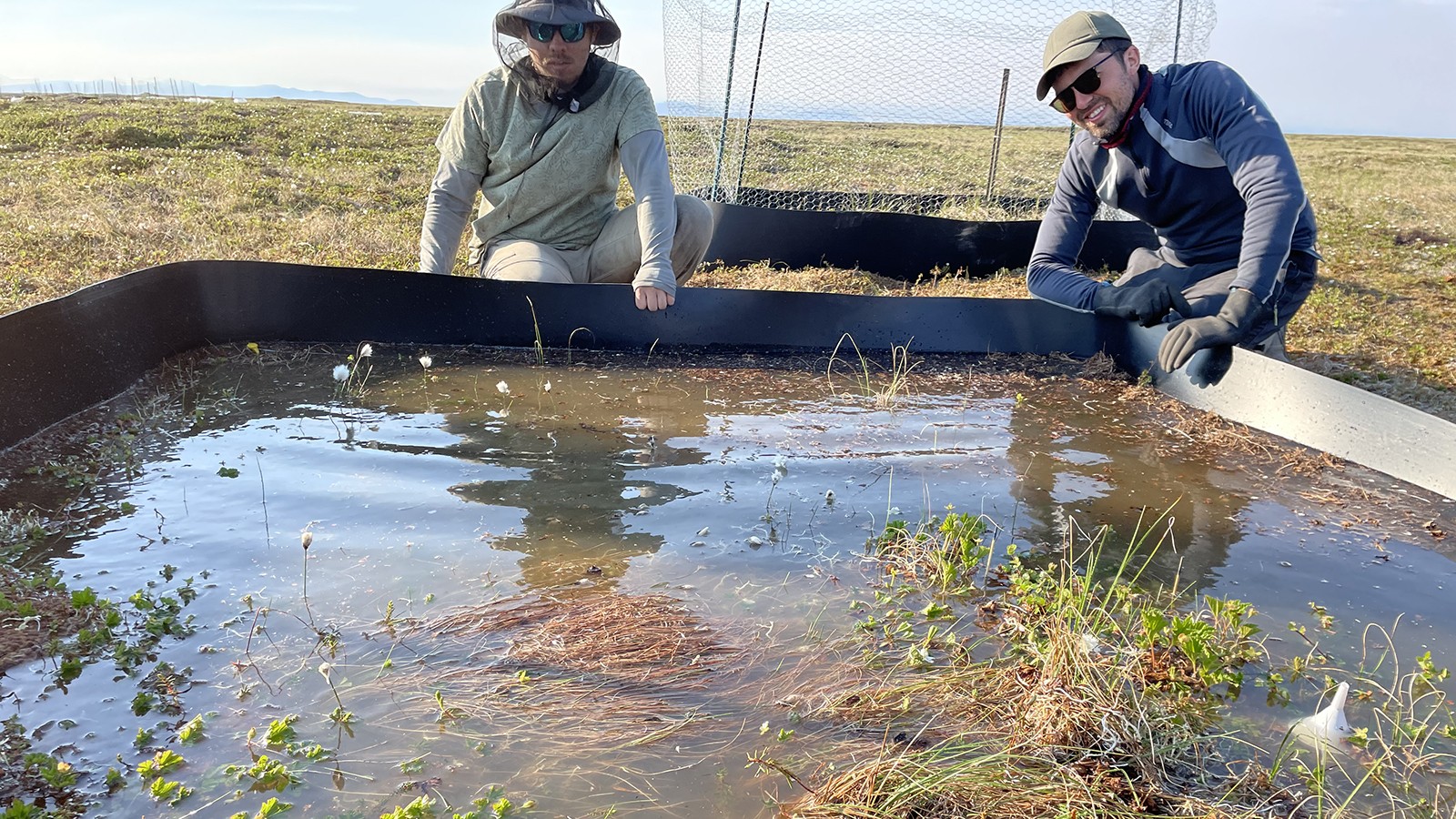Salt on Frost: Researchers Recording Impact of Once-in-a-Lifetime Storm on Alaska Coast
By Lael Gilbert |
USU graduate student Tyler Williams and post-doctoral researcher Matteo Petit Bon working on a research plot near Chevak, Alaska. The area was hit by a 70-year typhoon in September 2022, and the USU team is returning this summer to evaluate long-term vegetative changes in the wake of the storm. (Credit: Karen Beard)
For years, Utah State University ecologist Karen Beard has spent her summers camping and working on the mosquito-ridden tundra of Alaska’s Yukon Delta National Wildlife Refuge, doggedly documenting the persistent pace of climate change. The shifts she records are apparent only in increments—plants germinating a few days early, bird migrations becoming more variable, soil temperature rising slightly. But even these small changes, when multiplied across the wide stretches of Alaska’s vast landscape, have serious potential for impacts on the global system, so Beard has been paying attention.
Then, in September 2022, the pace of climate change got fierce. Typhoon Merbok barreled through the area, bringing nine-foot storm surges. The marshes and wetlands surrounding the town of Chevak, Alaska weren’t just inundated– they were subaquatic. Perched just a few feet above Hooper Bay’s high-tide mark, the area never had much margin of safety from tides of the Bering Sea, so during the worst storm in half-a-century, when wind destroyed homes and waves sank fishing boats, the storm pulled deep, brackish water further inland than anyone had ever seen, burying familiar landscapes and saturating the soil with saltwater and sediment. When the surge finally receded, it left behind hundreds of miles of drift lines composed of tangled vegetation and woody debris. Locals described it as the worst storm of their lifetime.
“This is the front line of climate change,” said Beard, from the Department of Wildland Resources in the Quinney College of Natural Resources.
The precarious position of the region was evident even before the storm—people from the nearby community of Newtok had already abandoned their traditional homeland for ground further inland because of increasingly unstable land affected by erosion and melting permafrost.
Immediately after the storm, Beard and her collaborators worked quickly to secure a grant from the National Science Foundation to document the short-term effects of the inundation on the ecology of the region.
"Events like this are happening more frequently,” she said. “It’s increasingly important that researchers build fundamental knowledge of how they might further impact these systems.”
With salt now saturating the soil, there is a chance that permafrost will be affected. Since the typhoon occurred before the ground was frozen for winter, Beard expects higher salt content and sediment to change greenhouse gas emissions and plant communities in the near term. Salt-killed tundra species like moss, lichen and woody species, may give way to grass-like species more tolerant to this type of disturbance. Fewer plants will grow where the new layer of sediment has buried vegetation. Overall, the team has hypothesized that flooding could increase the tundra's output of some greenhouse gasses, and they’ll begin measurement to monitor the changes.
Beard and her team will work this summer to determine the extent of the area impacted by the flood. They’ll identify vegetation impacted or killed by salt inundation and map newly deposited sediments and salinity changes in ponds. They will also work to capture aerial and satellite data to map the long stretch of debris left behind at the perimeter of the inundation. These maps will not only assist in further research, but will help the community of Chevak. They’ll be available to locals to aid in safer winter snowmobile travel, to identify important areas for firewood, and to evaluate the impacts of the storm on key fishing camps and subsistence areas where food like cloud berries were traditionally collected.
“A fundamental tenet of our research is to provide useful information to native Alaskans,” said Beard. “They are dealing with climate change in real-time, and we hope our findings help them deal with these dramatic shifts.”
WRITER
Lael Gilbert
Public Relations Specialist
Quinney College of Natural Resources
435-797-8455
lael.gilbert@usu.edu
CONTACT
Karen Beard
Associate Dean and Professor
Quinney College of Natural Resources
(435) 797-8220
karen.beard@usu.edu
TOPICS
Research 877stories Ecology 173stories Wildland 97stories Landscapes 51storiesComments and questions regarding this article may be directed to the contact person listed on this page.







